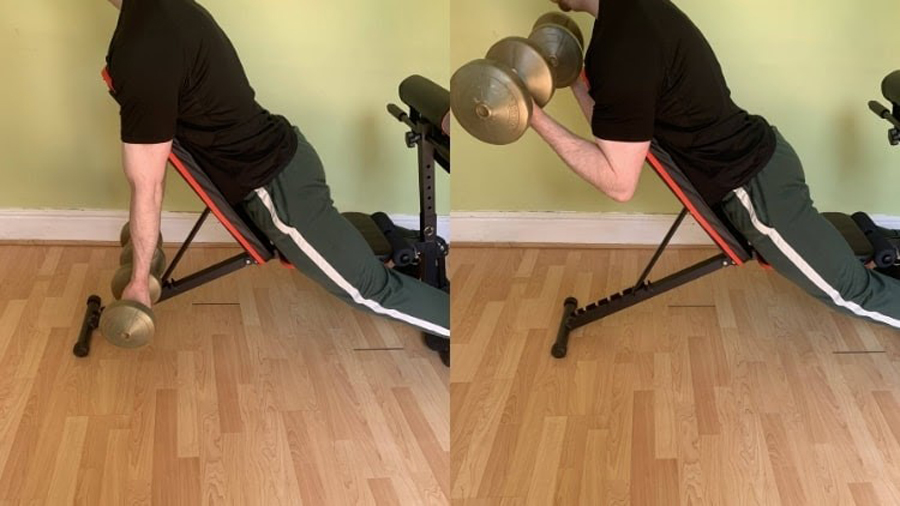
In other words, with the dumbbell spider curl, your biceps are forced to do all of the lifting.
Better yet, because you’re using dumbbells rather than a barbell, both of your biceps will naturally receive similar amounts of work because you have to curl each weight independently.
How To Do Spider Curls on an Incline Bench
- Set the bench’s back pad to a 60-degree angle and then grab a pair of weights with a supinated grip.
- Sit on the bench with your chest pressed against the backrest and let your arms hang forward.
- Curl the dumbbells toward your front delts while keeping your shoulders and elbows stationary.
- Keep on curling until your lower arms make firm contact with your biceps.
- Lower the dumbbells in a controlled manner until your elbows are locked out.
- Perform 3-5 sets of 8-12 reps in total.
Spider Curl Benefits
Enhanced Bicep Isolation
Not only does ego lifting lead to injuries, but it also takes tension off your biceps too.
But with spider curls, you couldn’t cheat the weight up (except maybe with your shoulders) even if you wanted to. That’s because your feet are planted firmly on the floor, and your hips and back are stabilized by the bench.
Therefore, your biceps have to handle all of the tension by themselves.
So while this enhanced bicep isolation might mean lifting a bit lighter than usual, it’ll actually lead to more hypertrophy in the long run because your biceps will be receiving more tension now that you’re not swinging the weight up with other body parts.
Better Inner Bicep Development
Any curl variation where your arms are in front of you (which is to say where your shoulders are flexed) emphasizes the short (inner) head of the biceps brachii.
Preacher curls are an example of such an exercise.
The dumbbell spider curl, of course, is another example.
Where spider curls differ from preacher curls, however, is in the resistance curve. While preacher curls place more tension on your biceps at the bottom of the rep—thus providing a stronger eccentric stretch—spider curls are far more challenging when your biceps are contracted.
So for optimal development, you should perform both bicep exercises. Spider curls certainly provide a better muscle pump because they exert more force onto your biceps when they’re in a shortened muscle position.
Ultimately, building your inner biceps with spider bench curls will make your arms look bigger when flexed and will help you to fill your t-shirt sleeves.
Stronger Compound Lifts
You’re only as strong as your weakest link.
If you want to overload your lats and traps with mass-building weights during pulldowns and rows, then you better have biceps that are at least decently strong.
Performing the DB spider curl can shortcut the muscle growth waiting time because the movement isolates your biceps better than virtually any other exercise.
The extra arm strength that you’ll develop via dumbbell spider curls will enable you to overload your back muscles with heavier weights, which in turn will help you to develop a more aesthetic physique and v-taper.
Spider Curl Variations
There’s more to building big arms than just having bulging biceps. If you truly want to optimize your physique development, then you need to curl with different grips to work the other arm muscles, such as the brachialis and brachioradialis.
Reverse Spider Curl
By placing your biceps in a weak position, the reverse spider curl forces your brachialis and brachioradialis muscles to do more work.
Developing your brachialis actually improves your bicep peak because the brachialis lies beneath the biceps. Therefore, when you make it bigger, it actually pushes your biceps muscles out and makes them appear larger and more peaked.
EZ Bar Spider Curl
Since curling the EZ bar requires less stabilization and coordination than lifting a pair of dumbbells, it’s naturally the tool of choice for testing your strength and applying heavy weight to your biceps.
The only disadvantage of the EZ spider curl is that, unlike the DB spider curl, it leaves you open to muscular imbalances because there’s a good chance that your stronger arm will do more of the lifting.
Hammer Spider Curl
While performing the dumbbell spider curl with a neutral grip does indeed reduce your bicep activation a tiny bit, it also enables you to lift heavier weights.
So although the extra resistance doesn’t completely compensate for the reduced bicep activation, you’ll really be honing in on those all-important fast-twitch muscle fibers by lifting heavy.
And besides, your brachioradialis and brachialis will be getting a bunch of tension as well.
Conclusion: Should You Do Spider Curls for Your Biceps?
Spider curls are highly effective for building bigger biceps and are also very versatile.
You can do the dumbbell spider curl on either an incline bench or a preacher pad. There’s no difference in muscle activation between the two; the only difference is that one or the other may be more convenient for you, depending on your equipment availability.
Make sure to perform curls that have your hands in neutral and pronated positions as well so that you can work all the muscles on the front of your arms.
Comments
comments